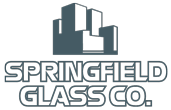You’ve probably seen most commercial buildings covered from top to bottom in glass. There’s a reason for that.
Glass isn’t just secure and eco-friendly; it’s aesthetically pleasing to look at and incredibly durable — especially when it’s installed with precision and care.
In today’s post, Springfield Glass Company will explain the various types of glass used in commercial construction projects by building developers.
Core Properties of Glass
Different glass types have their own unique attributes and properties.
Strength: Resistance or weight-bearing capacity of glass under pressure.
Transparency: The opacity of the glass is chosen for specific functionality (tinted glass deters UV rays) and preferred aesthetic (patterned or textured glass).
U-Value: How well a sheet of glass prevents heat from passing through or escaping.
Recyclable: All glass can be recycled and can be manufactured from recycled materials.
Different Types of Glass for Different Construction Needs
Need glass that’s humidity and heat-resistant? How about glass that resists high-impact natural disasters, such as tornadoes or hurricanes? There are various types of glass available for certain situations. Each has a strength and weakness.
1. Float Glass
Otherwise known as clear glass or soda-lime glass, it’s widely used for commercial properties and residential spaces. It’s created by molten glass over a bed of molten tin. It’s cooled down, then cut into a specific shape. It’s popular for window glass and is a high-demand form of glass.
2. Tempered Glass
Commonly known as safety glass. The glass’s strength and durability are doubled during manufacturing by being gradually heat treated in an oven. When tempered glass is fractured, it shatters into small pieces rather than large dangerous shards.
3. Annealed Glass
This is float glass that goes through the process of being heated and then slowly cooled with blasts of cold air on one side of the glass, making the glass appear colorless and clear.
Annealed glass is also used to form laminated and tempered glass.
4. Heat-Strengthened Glass
Similar to tempered glass, heat-strengthened glass is cooled gradually. It’s popular for buildings that are exposed to high temperatures.
5. Wired Glass
Reinforced with metal mesh or wires within the glass to deter breaks and falls. This is common in hospitals and schools, specifically for fire doors. Should a fire break out and high temperatures hit the glass, the wired frame holds the shards in place.
6. Laminated Glass
Two or more sheets of annealed glass are bonded with a thin layer of transparent material (often made from polyvinyl butyral). This film, along with the double panels, makes it stronger and more durable. It’s often known as safety glass.
It’s found in areas that require more security:
- Storefront windows
- Windows near walkways
- Glass storeroom doors
7. Insulated Glass
Also called Low-e glass, it works to inhibit the flow of heat through the glass by having two or more panes separated by a spacer (filled with argon gas). It keeps the heat outside on hot days and the hot air inside on cold days.
According to some research studies, some of the tallest buildings in Dubai utilize insulated glass because of how much energy savings is produced.
8. Mirrored Glass
It’s a type of float glass that is coated to reflect light, with one side coated with a metal material and the other side clear. This is used within bathrooms as hanging mirrors or as wall-mounted mirrors in homes and offices.
Get Quality Glass Installations from Springfield Glass Co.
Call us today for a free quote: (417) 883-6555
